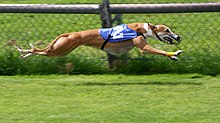Greyhound (dog breed)
| Greyhound | ||
|---|---|---|
|
|
||
| FCI Standard No. 158 | ||
|
||
| Origin : | ||
| Alternative names: |
Great English Greyhound |
|
| Withers height: |
Male : 71–76 cm. |
|
| Weight: |
Not fixed |
|
| Breeding standards: | ||
| List of domestic dogs | ||
The Greyhound is an FCI recognized dog breed from Great Britain , which is counted among the greyhounds ( FCI Group 10, Section 3, Standard No. 158 ).
origin
It is believed that the Celts brought the ancestors of the greyhound to the British Isles when they immigrated in the fourth century BC. Chr. With. During the 16th, 17th and 18th centuries, the Spanish greyhound ( Galgo Español ) was also exported in large numbers to Ireland and England. Through appropriate and targeted further breeding, the English greyhound emerged. He came to the USA via Great Britain.
The origin of the name cannot be determined with certainty, there are different derivations: "Gazehound" (sight dog), also "great hound", the word "gray" could be derived from the Old English, Celtic origin ("grech" or "greg") and means “dog”, the Latin “granus” (fast) is also available. The English " hound " stands for all hunting dogs that hunt independently .
Breed characteristics
The greyhound is a typical representative of the occidental greyhound, with good muscling, deep chest and long legs. The average height at the withers of a bitch is 70 cm, that of a male 74 cm. The weight varies between 23 and 33 kg. The racing greyhounds bred for racing purposes are mostly a bit smaller.
Greyhounds are always smooth-haired with a fine, thick coat. They are available in the colors black, white, brindle, fallow and blue, also in the basic color white, checked with each of these colors.
The gray lock can be mentioned as a breed-typical disposition , which can often occur in combination with too little water and a higher temperature in the event of strong, excessive stress. In this case, a very stiff gait (muscles cramped to the point of being unable to move) and often dark urine can be observed. The disease resembles the cross crate in horses and is based on a non-traumatic breakdown of muscle fibers . In this case, a veterinarian must be contacted immediately.
As with other greyhound breeds , the blood values of a healthy greyhound deviate significantly from non-breed-specific reference values, which can lead to misdiagnosis. The total protein, globulin, creatine and T4 thyroxine values, which are determined to check the liver, thyroid and kidney function, are also different. In urine tests to determine kidney disease, however, there is no significant difference in the reference values.
use
Earlier, the Greyhound was in the small game - rare for big game hunting used. In some countries this use for small game hunting is still common: These include the western United States, Spain, Portugal, Ireland, Russia and Pakistan, where greyhounds are used to hunt rabbits . In Great Britain, where greyhounds were tested for speed and stamina at events such as the Waterloo Cup until 2005 , this form of hunting has been banned since the Hunting Act 2004 .
In today's form bred for speed, greyhounds mainly run on the track in dog races , where they can reach top speeds of up to 80 km / h with an average speed of up to 65 km / h. The breed is also often used for coursing .
As family dogs, greyhounds in the house are cuddly and calm companions who are relatively undemanding in their keeping and care. Outside, however, their hunting behavior can be so pronounced that they can hardly run free. Track races or coursing can be used to compensate for this .
See also
Web links
Individual evidence
- ^ Bonnie Wilcox, Chris Walkowicz: Kynos-Atlas dog breeds of the world. Volume 2. German translation by Helga and Dieter Fleig . 3. Edition. Kynos-Verlag , Mürlenbach 1993, ISBN 3-924008-93-0 , p. 475: Greyhound.
- ^ S. Zaldívar-López, LM Marín, MC Iazbik, N. Westendorf-Stingle, S. Hensley: Clinical pathology of Greyhounds and other sighthounds . In: Veterinary clinical pathology / American Society for Veterinary Clinical Pathology . tape 40 , no. 4 , December 2011, doi : 10.1111 / j.1939-165X.2011.00360.x , PMID 22092909 , PMC 3816276 (free full text) - (English).
- ↑ SL Bennett, LA Abraham, GA Anderson, SA Holloway, BW Parry: Reference limits for urinary fractional excretion of electrolytes in adult non ‐ racing Greyhound dogs . In: Australian Veterinary Journal . tape 84 , no. 11 , November 1, 2006, pp. 393–397 , doi : 10.1111 / j.1751-0813.2006.00057.x (English).

